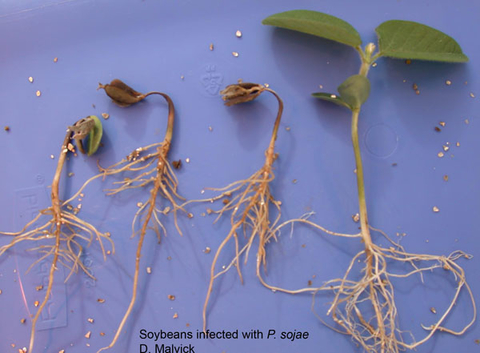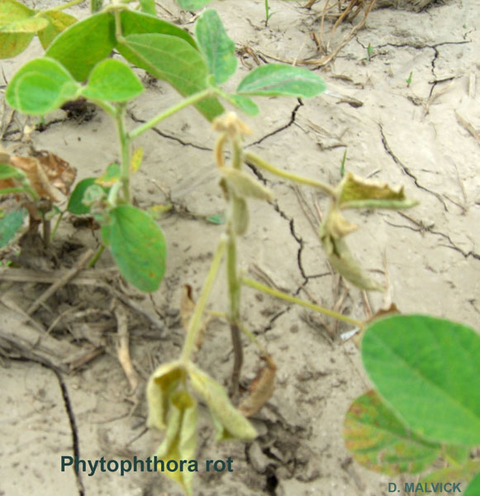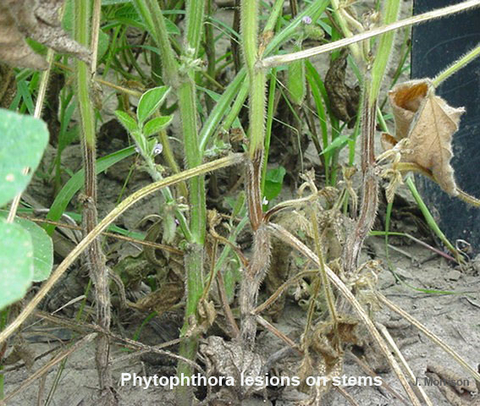Phytophthora root and stem rot is a significant disease in many areas where soybeans are grown. It can kill and damage seedlings and plants throughout the growing season from the time of planting nearly until harvest. This disease is favored by wet and warm soil conditions, especially saturated conditions early in the growing season. Disease management has been based largely on using soybean cultivars with major gene (Rps) resistance, but races of the pathogen now exist in many areas that overcome the major resistance genes. Thus, this disease continues to be a destructive problem in many areas.
Symptoms
Early season: Seedlings can be attacked and killed in the ground or soon after emergence. At seedling and later vegetative stages, infected stems appear bruised and are soft, secondary roots are rotted, the leaves turn yellow, and brown and plants can wilt and die. It is important to recognize that Pythium is a related pathogen that causes similar damage and symptoms on seeds and seedlings.
Mid or Late Season: Plants may die throughout the season. On infected plants, brown lesions form on the roots, the roots rot and degrade, and a dark chocolate-brown discoloration of the stem often extends from below the soil line upward into lower parts of the plant. Leaves turn yellow, wilt, and typically stay attached after plant death. Plants are often killed in patches or in sections of rows. In tolerant varieties, plants may be stunted but not killed. Symptoms on tolerant varieties may be restricted to root rot that results in hidden damage that may reduce yields. This disease can be confused with stem canker, which usually starts at a node and spreads up and down the stems of infected plants.
Conditions and timing that favor disease
Phytophthora can attack and rot seeds and seedling prior to or anytime after emergence. Plants can be infected early in the season and not show severe symptoms until later in the summer. The disease often occurs after wet weather, especially in low, poorly drained areas where saturated soil occurred early in the season. Clay and compacted soils favor this disease.
Causal pathogen
Phytophthora sojae is a fungal-like pathogen that survives in soil in the form of oospores for up to five to 10 years. The oospores are produced in infected plant tissue as it decomposes. Soybean is the only known crop host for this pathogen. This pathogen is most active and causes most damage in wet soils. P. sojae is the primary species that causes Phytophthora root and stem rot in most areas, but another unidentified Phytophthora species has been found in the Midwest that can also kill soybeans. The geographical range of this other species is not well understood.
Disease management
Several items should be considered for management of Phytophtora root and stem rot. Try to create a field environment that reduces the likelihood of saturated soil by taking steps to increase drainage where possible. Treatment of seed with the highest labeled rates of fungicidal compounds such as mefenoxam (Apron XL®) or metalaxyl (Apron®) can be beneficial. In all areas where Phytophthora root and stem rot has been a problem, resistant cultivars should be planted. The most common resistance genes that are widely effective are Rps 1c and 1k. Rps1a can be effective, but is not as effective in many areas as the other genes. Rps 3 and other genes can also be effective. For areas where the Rps genes are not working well due to the presence of pathogen races that overcome the resistance, cultivars with high levels of field tolerance (or partial resistance) should be planted. Crop rotation and tillage may be of some benefit.
Reviewed in 2018






